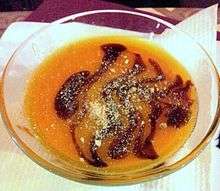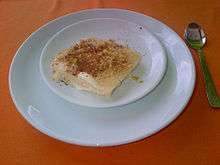Muhallebi
.jpg) | |
| Course | Dessert |
|---|---|
| Place of origin | Sassanid Persia (anecdotal) [1] |
| Serving temperature | Cold |
| Main ingredients | Rice flour, milk or almond milk, sugar |
Muhallebi, is a milk pudding that has legendary origins dating as far back as Sassanid Persia (224-651).[1] The basic ingredients are rice, sugar, rice flour and milk. The earliest recorded recipes date to the 10th century, but according to an anecdotal story of the dessert's origins a Persian cook served the pudding to the Ummayad general al-Muhallab bin Abi Sufa who liked it so much he named it after himself.
In the Middle Ages, muhallebi and its European counterpart blancmange were made with shredded chicken. The European recipes changed considerably over centuries. Though the traditional recipe is still common in Turkey, it is no longer widely available in other countries. Israeli malabi is usually flavored with syrup or culinary rose water, and sometimes the milk is replaced with grape juice to made the pudding pareve.[2][3]
History
Legend has it that muhallebi was introduced into Arab cuisine in the late seventh century by a Persian cook who served it to an Arab general by the name of Al-Muhallab ibn Abi Sufra. He liked it so much, he named it after himself. The earliest recipes dating to the 10th-century, featured three versions: milk thickened with ground rice, milk with rice grains and chicken, and an egg custard without rice.[1] The earliest recipe for muhallabiyya is attributed to Ibn Sayyar al-Warraq of Baghdad.[4] Two 13th-century Arab cookbooks, one by al-Baghdadi and another from Andalusia, have a spiced pudding variation made with mutton instead of chicken. The account of the pudding's Persian origins comes from the Andalusian cookbook.[1][4]
Known as blancmange in Europe, one 13th century recipe for blancmengier recorded in the Traité de cuisine écritvers is made with chicken, rice and sugar. Milk or almond milk are optional.[4] (One recipe for blank-mang in The Forme of Cury calls for blanched almonds.)[5] A recipe for mawmenye from The Forme of Cury includes cheese, egg yolks, saffron, clove sauce and galingale, in addition to the usual almond milk, rice, capon and sugar. Another called mammoniam in the Liber de Coquina is made from pounded capon meat, rice, almond milk, spices, and honey.[4]
There are records from the Ottoman Empire for two versions of muhallebi; a version with shredded chicken (tavuk göğsü) was served during regin of Mehmed the Conqueror and there is also a later recipe dating to 1530 for a meatless version. The meatless version of the Ottoman pudding was flavored with rose water.[1]
One 19th century English cookbook that gives a recipe for muhallebi calls it "Ramazan cakes". The recipe calls for boiling milk together with rice flour and sugar until the mixture reduces. The pudding is flavored with rose or jasmine extract, and allowed to cool before it is sprinkled with powdered sugar.[1]
Variations
In the modern era the traditional tavuk göğsü is no longer widely available, except in Turkey. This pudding does not taste at all like chicken, but the shredded meat gives it a distinctive texture. George Coleman De Kay said the pudding "owes its peculiar excellent flavour to the presence of the breasts of very young chickens, which are by some means so intimately blended and incorporated with the custard as to be scarcely distinguishable".[1][6] Kazandibi is a variation of the classic tavuk göğsü where a thin layer of pudding is caramelized before the custard is poured over it and allowed to set. The finished pudding is served upside down with the caramelized side on top.[1]
Mastic can be used as a flavoring for muhallebis—this is called sakızlı muhallebi.[7] Rice flour is used to thicken the pudding, but this can be combined or replaced with corn starch or wheat starch depending on the cook's preference.
In Israel, the pudding, known as "malabi" (מלבי), is one of the country's most popular desserts, and considered to a key local recipe. It is based on the Jewish-Turkish Sephardic recipe and made from cream and milk cooked with corn starch and rose syrup. Jewish malabi sometimes substitutes white grape juice for the almond milk.[8]
Similar to the Turkish keşkül, this version is typically topped with chopped peanuts and desiccated coconut; flavorings such as rose or orange water.[9]
Chefs Yotam Ottolenghi and Sami Tamimi, in Jerusalem: A Cookbook, define malabi as the "dessert form of sahlab," both a flour made from the tubers of the orchid genus Orchis and the name for the warm, less viscous version of the cold dessert.[10]
Culinary traditions
In some Sephardi homes, malabi is served to break the fast on the Jewish holiday of Yom Kippur. It is also eaten at Turkish Jewish weddings to symbolize the sweet life that lies ahead. Sephardim serve it on the festival of Shavuot when it is customary to eat dairy food, but according to food historian Gil Marks, the real reason is that the holiday is known in this community as the "feast of roses", and malabi is traditionally topped with rosewater.[11]


References
- 1 2 3 4 5 6 7 8 Isin, Mary (2013-01-08). Sherbet and Spice: The Complete Story of Turkish Sweets and Desserts. I.B.Tauris. ISBN 978-1-84885-898-5. Archived from the original on 2018-07-19. Retrieved 2018-07-16.
- ↑ "Recipe: Malabi (Milk Pudding)". MICHELIN Guide. Archived from the original on 2018-07-19. Retrieved 2018-07-19.
- ↑ "Modern Manna Recipe / Malabi - Milk and Orange Blossom Pudding". Haaretz. 2012-05-13. Archived from the original on 2018-07-17. Retrieved 2018-07-19.
- 1 2 3 4 Işın, Priscilla Mary (2015-07-23). "Blancmange". The Oxford Companion to Sugar and Sweets. Oxford University Press. ISBN 978-0-19-931339-6. Retrieved 2018-07-19.
- ↑ Morton, Timothy (2006-06). The Poetics of Spice: Romantic Consumerism and the Exotic. Cambridge University Press. ISBN 978-0-521-02666-6. Archived from the original on 2018-07-19. Retrieved 2018-07-19. Check date values in:
|date=(help) - ↑ Sidney Mintz (2015). The Oxford Companion to Sugar and Sweets. Oxford University Press. p. 746. ISBN 978-0-19-931339-6.
- ↑ The New York Times. Turkish Burned Milk Pudding. Archived from the original on 2016-03-26. Retrieved 2018-07-19.
- ↑ Marks, Gil (2010-11-17). Encyclopedia of Jewish Food. HMH. ISBN 978-0-544-18631-6.
- ↑ Maimon, Rotem (2013-02-08). "The Malabi Masters of Tel Aviv". Haaretz. Archived from the original on 2017-08-04. Retrieved 2018-02-05.
- ↑ Ottolenghi, Yotam; Tamimi, Sami (2012-10-16). Jerusalem: A Cookbook. Potter/TenSpeed/Harmony. ISBN 9781607743958. Archived from the original on 2017-08-04. Retrieved 2017-08-04.
- ↑ "Malabi | My Jewish Learning". My Jewish Learning. Archived from the original on 2017-09-03. Retrieved 2018-02-05.